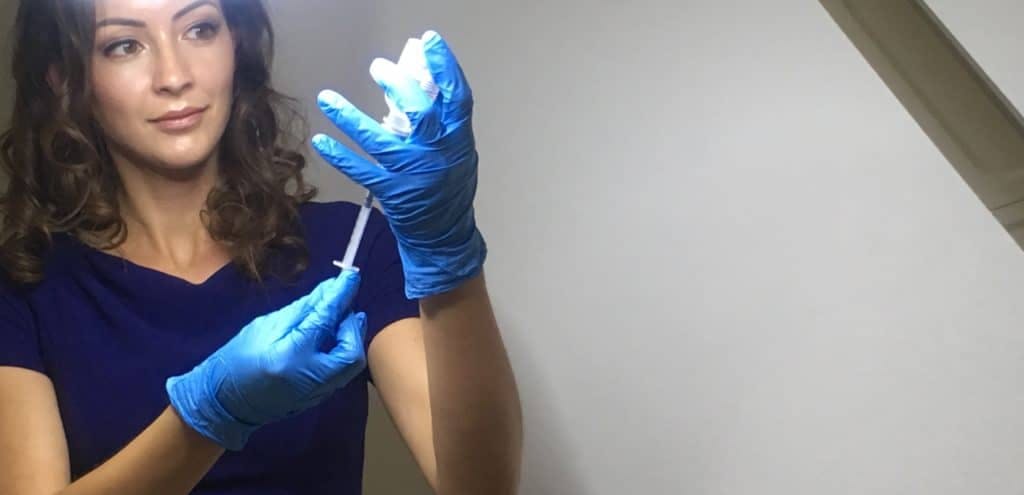Finding And Working With An Aesthetics Prescriber

One of the areas new injectors can find most daunting is setting up their practice. Finding and working with an aesthetics prescriber is often a particularly hot topic among our Level 7 students.
To help you understand the process better, we’ve put together this handy guide to the basics of what aesthetics practitioners need to know about working with a prescriber…

Why do aesthetics practitioners need to work with a prescriber?
Non-prescribing aesthetic practitioners need to work with a registered prescriber – or a prescribing service – in order to obtain the products they need to deliver their aesthetics treatments.
Botulinum toxin is a prescription-only medication (POM). Therefore, it must be prescribed by a doctor, dentist, nurse prescriber or prescribing pharmacist who has completed training in administering Botox.
Dermal fillers are not classed as a POM in the UK. For the purposes of regulation, the MHRA classified fillers as “medical devices” in 2020.
As such, qualified injectors may obtain dermal fillers either from a pharmacy or directly from manufacturers’ sales reps. It is normal for pharmacists in particular to ask to see copies of your training certificates and indemnity insurance before allowing you to place an order.
Any aesthetic nurses feeling inspired to train as prescribers may wish to read our article on Nurse Prescribing Courses.
You can also get some great insights on how to become a nurse prescriber from our Level 7 graduate and clinical trainer, Shantel Noble, RGN, who recently completed her V300.
What’s the best way to find a prescriber for my aesthetics business?
We would advise getting a personal recommendation, where possible.
If you don’t know any prescribers, try asking your peers and other medical professionals – especially those who are local to where you will be practicing. Fellow students from your training courses, or the clinical trainers themselves, may also be able to recommend registered prescribers to you.
Harley Academy students are given exclusive access to our support Comma, the online community for medical aesthetics. This is a great place to get recommendations and advice from aesthetics specialists.
However, any medical aesthetics practitioner can also join the main Comma network and post in the Prescribing Comma in order to find local prescribers.
If a non-prescriber and a prescriber choose to ‘buddy up’, both need to have CPD-accredited certification to show they have successfully completed a minimum of Foundation Training (or an equivalent). They also need to have the appropriate insurance coverage.
The prescriber must have one full year of experience within the field before prescribing for anyone else within aesthetics.
Alternatively, you may prefer to use a prescriber service. These organisations will send a member of their network of registered prescribers to consult with your patient and write a script, when needed.
In Great Britain you can check if a pharmacist is registered with the General Pharmaceutical Council (GPhC) by entering their name and/or registration number into the GPhC pharmacists database.

How do I work with a prescriber to order filler and botox?
Although you will be performing the actual treatment, prescribers must first carry out a face-to-face consultation with each patient prior to writing their individual script for botulinum toxin.
This means that, whether you work with an individual or a prescribing service, they will need to conduct a medical consultation with each patient in person. Virtual prescriber consultations, via Zoom or Skype for example, are not permitted for botulinum toxin due to it being a POM.
They will charge a fee for this two-part service; the sum can vary but is generally approximately 10 percent or £40 per patient.
Where dermal fillers are concerned, you do not need to involve a prescriber in the consultation or ordering process as these are not considered a POM in the UK.
Register with a range of pharmacies who dispense fillers you are interested in, then keep an eye on their communications as they will likely offer various deals throughout the year. Care Quality Commission (CQC) registered aesthetic pharmacies are recommended here.
Additionally, if you would like to use a particular brand of dermal filler, simply find out who the manufacturer is and contact them directly to get their sales representative’s details. They will be happy to walk you through any particular requirements for orders and special offers.
How can I tell if a pharmacy is genuine?
All pharmacies in Great Britain, including online pharmacies, must be registered with the GPhC. They must also meet the specific standards required of those registered pharmacies. You can check if a British pharmacy is registered by entering their details into the searchable GPhC pharmacy database.
If you have any doubts, again, don’t be afraid to see if your peers have any feedback that may prove helpful.

Will they need to use the same pharmacies every time?
Not necessarily. Prescribers can upload paper scripts where necessary but many find it much easier to use e-scripts and deal with the same pharmacies regularly. It can be beneficial to build strong relationships with a number of pharmacies in the area.
Can a prescriber tell me how many different products I will need when starting out?
New injectors should ensure they have botulinum toxin and all the emergency medications. Our Level 7 students will be aware of this list which includes adrenaline.
Fillers and additional botulinum toxin can be ordered as required in addition to this.
Your prescriber may be able to advise you but this information should be readily available, both as part of your training and from your insurers.
We hope you find this guidance useful; did it answer all your questions? Let us know if there are any other queries you have about working with a prescriber. You can contact us in the traditional ways, as well as on our official Instagram page.
All information correct at the time of publication
Download our full prospectus
Browse all our injectables, dermal fillers and cosmetic dermatology courses in one document
By submitting this form, you agree to receive marketing about our products, events, promotions and exclusive content. Consent is not a condition of purchase, and no purchase is necessary. Message frequency varies. View our Privacy Policy and Terms & Conditions
Attend our FREE open evening
If you're not sure which course is right for you, let us help
Join us online or in-person at our free open evening to learn more
Our Partners












STAY INFORMED
Sign up to receive industry news, careers advice, special offers and information on Harley Academy courses and services

